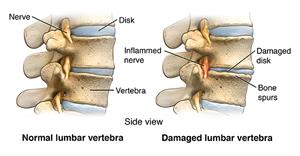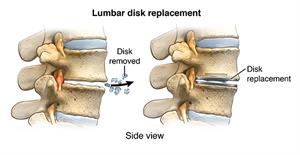Lumbar Disk Replacement
What is a lumbar disk replacement?
A lumbar disk replacement is a type of back or spine surgery. Your spine is made up of bones called vertebrae that are stacked on top of each other. Disks between the vertebrae work like cushions. They allow the vertebrae to rotate and move without the bones rubbing against each other. The lumbar vertebrae and disks are at the bottom of your spine. Lumbar disk replacement involves replacing a worn or degenerated disk in the lower part of your spine with an artificial disk made of metal or a combination of metal and plastic.

Lumbar disk replacement is often seen as an alternative to the more common spinal fusion surgery. Fusion permanently joins 2 vertebrae together. Lumbar disk replacement is a major surgery. It requires general anesthesia and a hospital stay.
Why might I need a lumbar disk replacement?
The main reason you would need a lumbar disk replacement is to treat low back pain. Still, not everyone with low back pain is a good candidate for this surgery. Your healthcare provider will need to do some tests to see if it’s right for you.
You may need this surgery if:
-
Your back pain mostly comes from only 1 or 2 disks in your lower spine.
-
You have no major joint disease or compression on the nerves of your spine.
-
You are not too much overweight.
-
You haven’t had spinal surgery before.
-
You don’t have scoliosis or some other spinal deformity.
What are the risks of a lumbar disk replacement?
Like all surgeries, lumbar disk replacement poses some risks. A disk replacement needs greater access to the spine than standard lumber fusion surgery. This also makes it a riskier procedure.
Some possible risks of this surgery are:
-
Infection of the artificial disk or the area around it
-
Dislocation or dislodging of the artificial disk
-
Implant failure or fracture (break)
-
Implant loosening or wear
-
Narrowing of the spine (stenosis) because of the breakdown of spinal bones
-
Problems due to a poorly positioned implant
-
Stiffness or rigidity of the spine
-
Blood clots in your legs due to decreased activity
-
Injury to nearby nerves
There may be other risks, depending on your specific health problem. Understand the risks and benefits of lumbar disk replacement. Also discuss any concerns with your surgeon before the procedure.
If you have pain, ask your healthcare provider whether the surgery will ease your discomfort. A lumbar disk replacement usually decreases pain, but does not stop it completely. It's important to understand what the surgery can do for you.
How do I get ready for a lumbar disk replacement?
Along with a physical exam and health history, you may need X-rays, an MRI or CT scan, discography, and blood tests. These help the healthcare provider identify the true nature and extent of your back pain and spinal damage. They may also be needed to get a better view of the spine and decide whether the surgery is right for you. You may need nerve conduction studies and electromyography to see if you have nerve damage.
You may be asked to stop smoking as part of getting ready for spine surgery. Smoking puts you at greater risk for wound infections after surgery. It also delays the bone's healing. The bone must be able to heal for the surgery to be a success. If you need help to stop smoking, talk with your healthcare provider.
Tell your healthcare provider about all medicines you are taking. This includes prescription and over-the-counter medicines and any vitamins, herbs, and supplements. Some of these may affect things like healing and blood clotting. So you may need to stop taking them before the procedure.
You will be asked to sign a document called an informed consent. Before signing, your healthcare provider will explain the risks, and benefits of your surgery, and other treatment choices. You will be asked if you have questions. Write down your questions and have all of them answered before you give your consent to have the surgery done.
Follow any directions you are given for not eating or drinking before surgery. You will probably have to stay in the hospital for a few days. You may not be allowed to drive for some time after surgery. For a short time after surgery, you may need some help at home with things like bathing, dressing, cleaning, and shopping. You may want to arrange this ahead of time.
Talk with your healthcare provider so you know exactly what you need to do before your procedure.
What happens during a lumbar disk replacement?
You will have an IV (intravenous) line put into a vein in your hand or arm through which an anesthetic is given. The medicine will put you into a deep sleep. It will keep you from feeling pain during the surgery. You will be lying on your back for this surgery.
A team of surgeons (usually a vascular surgeon and an orthopedic or neurosurgeon) will do the procedure together. The surgeon will make an incision in your abdomen. Your organs and blood vessels will be moved to the side to allow access to your spine.
The surgeon will remove the damaged disk and put the new artificial disk in place. Your organs and blood vessels are put back in place and the incision will be closed.
 |
| PNerv_20140108_v0_002 |
After surgery, you will be taken to a recovery area for close monitoring until you are awake from the anesthesia. You will still have an IV line. You may also have a catheter in your bladder to make urination easier. When you are fully awake and alert, you will be taken to your hospital room.
Talk with your healthcare provider about what you can expect your lumbar disk replacement procedure to be like.
What happens after a lumbar disk replacement?
You will probably need to stay in the hospital for a few days after your surgery. Because a lumbar disk replacement doesn’t need bone to heal, the recovery period may be faster than with other back surgeries. You’ll be given pain medicines if you need them. You may be encouraged to stand and walk within the first day after surgery. Your IV and bladder catheter will be removed within a few days of surgery.
You will be shown how to move correctly and how to do exercises, such as gentle trunk twists. This will keep your spine limber. It will also help you have a quicker rehabilitation and recovery. As your recovery progresses, you’ll be encouraged to walk and stretch. You’ll need to stay away from any jarring activities or motions for quite a while. Your recovery may take from a few weeks to a few months.
A lumbar disk replacement generally improves pain. But it does not stop it completely. Talk with your healthcare provider to get a realistic idea about what you can expect after this surgery. Also talk with your provider about instructions you need to follow after surgery, such as:
-
What you can and can't do
-
How to care for your incision
-
What signs of problems you need to watch for
-
When you need to follow up with your healthcare provider
-
What lifestyle habits can keep your spine healthy. For example, this might be exercising, staying at a healthy weight, and not smoking.
Next steps
Before you agree to the test or procedure make sure you know:
-
The name of the test or procedure
-
The reason you are having the test or procedure
-
What results to expect and what they mean
-
The risks and benefits of the test or procedure
-
What the possible side effects or complications are
-
When and where you are to have the test or procedure
-
Who will do the test or procedure and what that person’s qualifications are
-
What would happen if you did not have the test or procedure
-
Any alternative tests or procedures to think about
-
When and how will you get the results
-
Who to call after the test or procedure if you have questions or problems
-
How much you will have to pay for the test or procedure